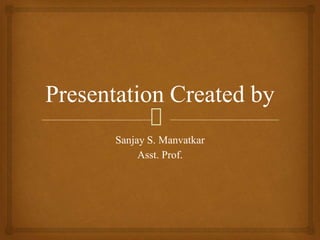
Analysis and design tool
- 1. Presentation Created by Sanjay S. Manvatkar Asst. Prof.
- 2. Analysis & Design Tools Decision tree & decision Table DFD (Data Flow Diagram) DD ( Data Dictionary) 1) Element of DD 2) Advantages & Disadvantages of DD Input & Output Design. Pseudo Code Case Studies on Above Topic.
- 3. Decision tree & decision Table We know that software analysis and design is the intermediate stage which helps human-redable requirements to transformed in to actual code. 1. Decision Tree:- Introduction:- Decision making is an integral part of any organization no matter how small, simple or big and complex it may be.
- 4. Decision tree is a decision support analysis and design tools that uses a tree like graph or model of decision and their possible consequences. Decision tree shows which condition to consider first, which is second and so on. Decision tree also shows the relationship of each condition and its permissible actions. Decision sequence starts from the root of the tree that is usually on the left of the diagram. Decision Tree can be defined as “ a graphical representation of specific decision situations in a structured decision process.
- 6. Example :-Discount policy of book for Individuals & Bookstores:-
- 7. Example 2:- Discount policy for Saree manufacturer:-
- 8. Advantages & Disadvantages of Decision Tree Advantages 1. Decision tree are simple to understand and interpret. 2. It helps the analyst to identify the actual decision to be made. 3. Decision trees can be combined with other decision techniques. Disadvantages 1. A Large number branches with many path will confuse rather than help in analysis. 2. Large decision trees can be hard to interpret. 3. Decision tree are uses a step function that can have large errors.
- 9. 2.DT (Decision Table) Introduction:- 1. Decision table is a graphical method for Explaining the logic of making decision in tabular format. 2. In DT set of Condition and Actions are available. Ex. Calculate Discount rates.
- 11. 1. Condition stub:- will shows the condition that determines which action will result. 2. Condition Entries:- combination of conditions expressed as rules. 3. Action Stub:- which contains Possible Actions which can occur as result of the different condition combinations. 4. Action Entries:- Which contains the action to be taken. -Right part of a Decision Table shows, each column is named by a rule number or rule identifier.
- 12. Sample Format Of DT:-
- 13. Example of Decision Table
- 14. Advantages & Disadvantages of Decision Table (DT) Advantages 1. Decision Table Can be changed according to situation. 2. DT may be easier to construct than flowchart. 3. It Provides Compact Representation of making process. Disadvantages 1. DT does not show the flow of logic for the solution to a given problem. 2. If there are too many alternatives it is difficult to list in DT. 3. It may be difficult for the programmer to translatedecision table in to prog.
- 15. 3. DFD (Data Flow Diagram) DFD is a graphical representation of the flow of data through a information system. DFD represents System Data in a “Hierarchical Manner” with required levels of details. For DFD Creation We use various types of symbols are used.
- 16. Custome r 1. Entry---------------- 2. Process------------- 3. Data Flow--------- Verify Order 4. Data Store-------- Product/ Data Store
- 17. Types of DFD There are two types of DFD both of which supports a top- down approach to system analysis. 1. Logical DFDs:- Specify the various logical processes performed on data i.e. type of operations performed. 2. Physical DFDs:- shows how system will be implemented. work done in manually or computerized.
- 18. Sample of DFDs
- 19. DFD For Online Shopping System Level 0
- 20. Online Shopping System:- Level 1 & Level 2
- 21. Advantages & Disadvantages of DFDs (Data Flow Diagram) Advantages 1. Simple graphical step & easy to understand for technical & non technical user.2. It is useful for communicating current system knowledge to 3. DFD can provide a detailed representation of systemcomponents. Disadvantages 1. DFD undergoes lot of alteration before going to users, so makes the process slow. 2. DFD takes long time to create. 3. Different DFD models have different symbols since it is complicated.
- 22. DD (Data Dictionary) Introduction:- DD is an organized collection of relational information. DD is centralized repository of information about system and its elements such as meaning , relationships, origin, usage and format. DD Consist of following items Name, Alias, use , Content description, Additional information etc.
- 23. Sample of DD (Data Dictionary)
- 24. Example of DD (Data Dictionary)
- 25. Advantages & Disadvantagesof DD (Data Dictionary) Advantages 1. DD manage the details in large system and DD improves Consistency. 2. DD is used to communicate common meaning for all system element. Disadvantages 1. For large organization a DD is grows rapidly in size and complexity. 2. DD is difficult to maintain manually.
- 26. Input & output Design Input Design:- Input design means “Designing the screen used to enter the information, as well as any forms on which users write or type information like time card”. The goal of input design is to capture accurate information for the system simply and easily. The fundamental principles for input design reflect the nature of the inputs & ways to simplify their collection.
- 27. The system analyst should work out the following input design details:- 1. What data is to be input? 2. What medium is to be used? 3. How should the data be arranged or coded? 4. The interface to be provided to the users for providing input. 5. Entities & transactions requiring validation to detect errors. 6. Ways to perform input validation & measures to take in case error occurs.
- 28. Thank you